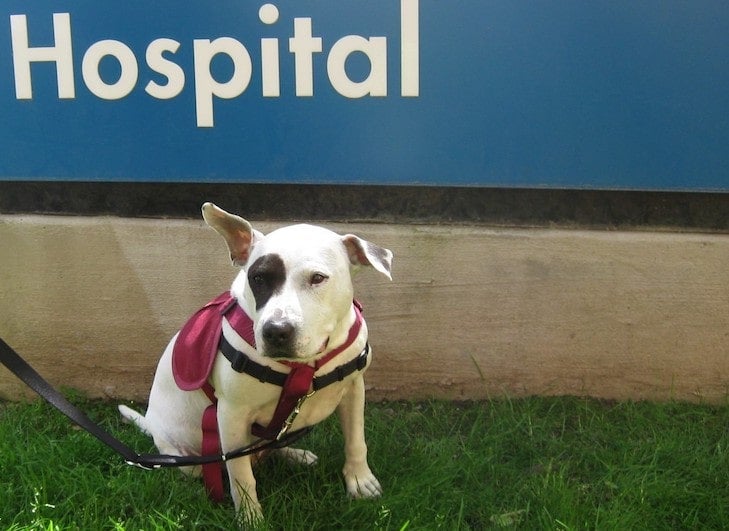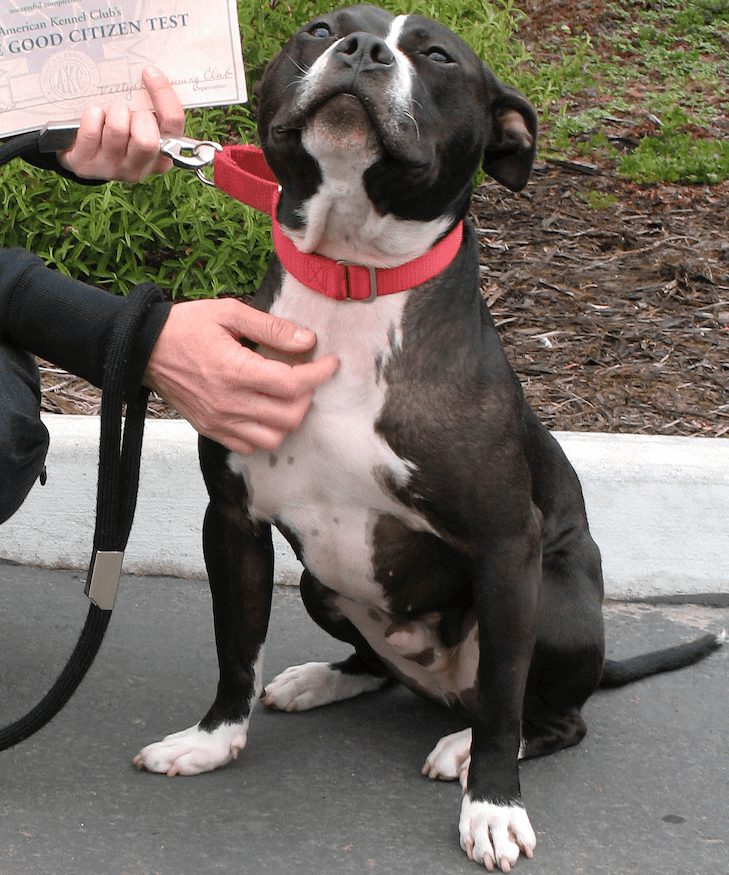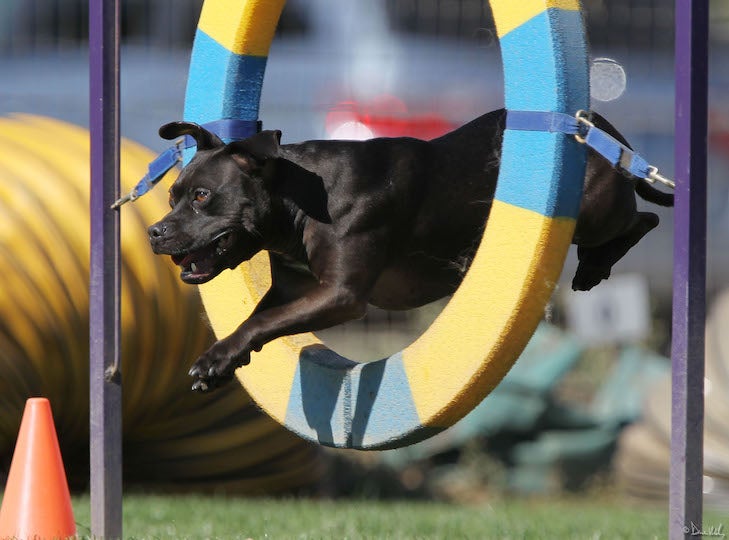
Jonny Justice knows how to work a room. As a therapy dog, he’s spent years bringing joy to countless people, in the reading program at his local library and visiting children with terminal illnesses at the San Francisco nonprofit Family House. On one occasion, Jonny performed his whole repertoire of 25 tricks for a young girl who was weak after extensive chemotherapy. He shook hands, ran circles under her legs, crawled across the floor, and even imitated a car. Soon, she was on her feet, giggling and running after Jonny.
“This is the first time my daughter’s smiled in weeks,” her mother told Cris Cohen, Jonny’s owner.
The kicker? Jonny is one of the original infamous “Vick dogs”, and he was very nearly euthanized before he ever had a chance to bring so much joy into the world.
The story of the Michael Vick dogs is well known by now. In 2007, authorities searched a property in Virginia owned by Atlanta Falcons quarterback Michael Vick. They seized 51 dogs that had been forced to work in a dogfighting ring. The site betrayed grisly evidence of the horrifying cruelty that had taken place there. There were even several dogs buried on the grounds.
Previously, dogs seized in fighting cases were invariably deemed too damaged to recover, and usually euthanized. This policy was supported by several animal welfare organizations that maintained that the Vick dogs had endured so much trauma, euthanasia was the only kind choice.
Victories for Vick Dogs

These dogs changed all that. When a chorus of voices rang out advocating for the Vick dogs, the authorities relented. A panel of experts assessed the dogs and deemed 47 of the 51 suitable for rescue. And that was just the beginning of the story.
Jonny Justice is just one of the many Vick dogs that went on to a life of achievement. Jonny and 12 other rescued dogs were driven across the country by staff from the Oakland-based group BADRAP. Many of the remaining dogs went to Best Friends Animal Society in Utah for further socialization.
Within months, many of the dogs rescued by BAD RAP were living happily in loving homes alongside other dogs, children, and even cats. Many of them wowed the crowds that came to watch their training classes.
“They were ready to hit the ground running with a new way of living in the world,” said BAD RAP director Donna Reynolds.
Reynolds emphasized the dogs’ resilience. These pups didn’t arrive damaged, they were just lacking in socialization. So, Reynolds and her team offered that to them in a way that’s structured and supported. That meant, among other things, having them pass their Canine Good Citizen (CGC) tests, the American Kennel Club’s gold-standard behavioral certification.
From Fighting Dogs to Canine Good Citizens
Over the course of six weeks, the dogs gathered in a local park to train in skills such as accepting a friendly stranger, walking through a crowd, and reacting calmly and politely to other dogs and distractions. At first, the dogs’ history had to be kept secret for legal reasons. Once the secrecy was lifted and word got out that there were Vick dogs in the neighborhood, however, people began to turn out in droves to watch them.
“It was a very emotional thing for a lot of people,” said Letti de Little, the owner of Uba, a dog rescued from Vick’s fighting ring. “Our training classes became this venue for people to experience the fact that these dogs were alive.”
Not just alive, but thriving. So much so, in fact, that the spectators struggled to tell which of the dogs were Vick dogs.

Aside from teaching the dogs valuable obedience skills, the CGC gave them structure, which, as de Little points out, is crucial for any young, unsure, and uncertain creature of any kind, human or animal. For these dogs that had spent their early years being severely mistreated by humans, the CGC was also an opportunity to bond with new families and learn what would be required of them in their new lives.
“Prepping for the CGC exam increased the depth of the bond between Jonny Justice and me,” said Cohen. “There has to be trust and communication between you and your animal to be successful with that exam. The dog has to trust you, and you have to trust your dog.”
In fact, CGC training proved such a valuable bonding experience that Grace, a sassy Vick dog who also went on to do therapy work in hospitals, got her certification twice. She first passed the test with her foster family, then again with Susan Mitchell, who later became her owner.
“I knew she could do it,” said Mitchell. “It was more for me to get the relationship of training her down. So much of it’s in the rapport that you have with the dog.”
Once they’d passed their CGC certifications, the sky was the limit for the Vick dogs. Among others, Jonny and Grace provide treasured support for hospital patients as therapy dogs. Uba found a passion for Scent Work. And Audie the superlative Staffordshire Bull Terrier became an Agility star.
How Humans Can Learn From Vick Dogs
So much, then, for the idea that dogs rescued from fighting rings were too damaged to live. The Vick dogs have shown the world that just about any dog can excel, especially when they have the benefit of a trusting relationship with their human.
Indeed, despite these pups’ rough pasts, they just needed the right environment, proper training, and humans who could help them thrive.

“With dogs from fighting cases, and all dogs that come from difficult backgrounds, there’s a tendency to build a story around, oh, my dog has this problem because they come from this terrible background,” said de Little. “What I learned from Uba is that he doesn’t care where he came from. He has this huge joie de vivre. He’s always excited about the day, and he doesn’t look backward.”
“We never really thought of [Grace] as a Vick dog, she was just our pet,” added Mitchell.
In fact, this is exactly why Mitchell and her family decided not to tell anyone about Grace’s start in life. They didn’t want others to judge the dog based on where she had spent her early months. Rather, they wanted Grace to be seen as the dog she should have been all along.
Increasingly, ever more dogs are able to become who they should have been all along, thanks in part to the stigmas that the trailblazing Vick dogs helped to overcome.

